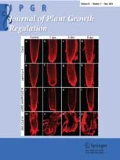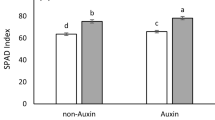Abstract
To investigate the effects of nanofertilizers and biofertilizers on the morpho-physiological and biochemical traits of safflower under full irrigation and water deficit stress, this study was carried out as a split-plot experiment based on a Randomized Complete Block Design with three replications at Urmia University in 2015. The main plot was full irrigation (control) and irrigation disruption at heading, flowering, and grain filling stages. Fertilizers, including control (without fertilizer), biofertilizer, water spray, foliar application of nanofertilizers, chemical fertilizers, and combined application of fertilizers, were assigned to the subplot. Plants under full irrigation and combined fertilizers had maximum height and chlorophyll a, whereas the lowest ones were obtained in irrigation disruption at the heading stage and control treatments. The maximum oil content (28.41%) was detected in irrigation disruption at the grain filling stage and nanofertilizer treatment, the lowest (21.96%) was obtained at irrigation disruption at the flowering stage and water spray treatment. The highest proline (397.21 µg g−1 fresh leaf) was found in irrigation disruption at the grain filling stage and water spray treatment, and the lowest (154.68 µg g−1 fresh leaf) was obtained at full irrigation and water spray treatment. Irrigation disruption at the heading stage and control treatments decreased carbohydrate content of fresh leaves by 86.54% compared to full irrigation and the combined fertilizers treatment. Irrigation disruption increases saturated fatty acids (palmitic and stearic acid) and decreases vitamin E and linoleic acid. The combined application of fertilizers significantly increased safflower oil quality. Overall, concerning the obtained highest oil percentage (28.41%), irrigation disruption during grain filling reduced water consumption and application of combined fertilizer via improving oil quality, so it is recommended to farmers.


Similar content being viewed by others
References
Arnon DI (1949) Copper enzymes in isolated chloroplasts polyphenol oxidase in beta vulgaris. Plant Physio l24(1):1–15
Besbes S, Blecker C, Deroanne C, Lognay G, Drira NE, Attia H (2005) Heating effects on some quality characteristics of date seed oil. Food Chem 91(3):469–476
Bhardwaj D, Ansari MW, Sahoo RK, Tuteja N (2014) Biofertilizers function as key player in sustainable agriculture by improving soil fertility, plant tolerance and crop productivity. Microb Cell Fact 13(1):1–10
Biari A, Gholami A, Rahmani HA (2008) Growth promotion and enhanced nutrient uptake of maize (Zea mays L.) by application of plant growth promoting rhizobacteria in arid region of Iran. J Biol Sci 8(6):1015–1020
Bouchereau A, Clossais-Besnard N, Bensaoud A, Leport L, Renard AM (1996) Water stress effects on rapeseed quality. Eur J Agron 5(1–2):19–30
Bulluck Lii LR, Brosius M, Evanylo GK, Ristaino JB (2002) Organic and synthetic fertility amendments influence soil microbial, physical and chemical properties on organic and conventional farms. Appl Soil Ecol 19(2):147–160
Carvalho ISD, Miranda I, Pereira H (2006) Evaluation of oil composition of some crops suitable for human nutrition. Ind Crop Prod 24(1):75–78
Coşge B, Gürbüz B, Kiralan M (2007) Oil content and fatty acid composition of some safflower (Carthamus tinctorius L.) varieties sown in spring and winter. Int J Nat Eng Sci 1(3):11–15
Dornbos DL Jr, Mullen RE (1992) Soybean seed protein and oil contents and fatty acid composition adjustments by drought and temperature. J Am Oil Chem Soc 69(3):228–231
Fereres E, Soriano MA (2006) Deficit irrigation for reducing agricultural water use. J Exp Bot 58(2):147–159
Fernandez-Martinez J, Del Rio M, De Haro A (1993) Survey of safflower (Carthamus tinctorius L.) germplasm for variants in fatty acid composition and other seed characters. Euphytica 69(1–2):115–122
Frank HA, Cogdell RJ (1996) Carotenoids in photosynthesis. Photochem Photobiol 63(3):257–264
Fuller G, Diamond MJ, Applewhite TH (1967) High-oleic safflower oil stability and chemical modification. J Am Oil Chem Soc 44(4):264–266
Geerts S, Raes D (2009) Deficit irrigation as an on-farm strategy to maximize crop water productivity in dry areas. Agric Water Manag 96(9):1275–1284
Gusain YS, Singh US, Sharma AK (2015) Bacterial mediated amelioration of drought stress in drought tolerant and susceptible cultivars of rice (Oriza sativa L.). Afr J Biotechnol 14(9):764–773
Haghighati A (2010) Study on the effects of nitrogen and phosphorus fertilizers on the yield and oil content of safflower lines in drylands. Res J Agron 4(3):57–62
Herbel BK, McGuire MK, McGuire MA, Shultz TD (1998) Safflower oil consumption does not increase plasma conjugated linoleic acid concentrations in humans. Am J Clin Nutr 67(2):332–337
Horwitz W (2000) Official methods of analysis of AOAC International (No.C/630.240 O3/2000)
Jiang Y, Huang B (2001) Drought and heat sress injury to two cool-season turfgrasses in relation to antioxidant metabolism and lipid peroxidation. Crop Sci 41(2):436–442
Khot LR, Sankaran S, Maja JM, Ehsani R, Schuster EW (2012) Applications of nanomaterials in agricultural production and crop protection: a review. Crop Prot 35:64–70
Knowles PF (1965) Variability in oleic and linoleic acid contents of safflower oil. Econ Bot 19(1):53–62
Kulekci M, Polat T, Ozturk E (2009) The determination of economically optimum nitrogen dose in safflower production under dry conditions. Bulg J Agric Sci 15(4):341–346
Kumar H (2000) Development potential of safflower in comparison to sunflower. Sesame Safflower Newsl 15:86–89
Magné C, Larher F (1992) High sugar content of extract interferes with colorimetric determination of amino acids and free proline. Anal Biochem 200(1):115–118
Mathur N, Vyas A (2000) Influence of arbuscular mycorrrhizae on biomass production, nutrient uptake and physiological changes in Ziziphus mauritiana L.am. under water stress. J Arid Environ 45(3):191–195
Metcalf LC, Schmitz AA, Pelka JR (1966) Rapid preparation of methyl esters from lipid for gas chromatography analysis. Anal Chem 38:514–515
Mirzakhani M, Ardakani MR, Band AA, Rejali F, Rad AS (2009) Response of spring safflower to co-inoculation with Azotobacter chroococum and Glomus intraradices under different levels of nitrogen and phosphorus. Am J Agric Biol Sci 4(3):255–261
Mirzakhani M, Ardakani MR, Rejali F, Shirani Rad HS, Miransari M (2014) Safflower (Carthamus tinctorius L.) oil content and yield components as affected by co-inoculation with Azotobacter chroococcum and glomus intraradices at various N and P levels in a dry climate. In: Use of microbes for the alleviation of soil stresses. Springer, New York, pp 153–164
Navari-Izzo F, Quartacci MF, Izzo R (1989) Lipid changes in maize seedlings in response to field water deficits. J Exp Bot 40(6):675–680
Nelson R, Achar PN (2001) Stimulation of growth and nutrient uptake by VAM fungi in Brassica oleracea var. capitata. Biol Plant 44(2):277–281
Quartacci MF, Pinzino C, Sgherri CL, Navari-Izzo F (1995) Lipid composition and protein dynamics in thylakoids of two wheat cultivars differently sensitive to drought. Plant Physiol 108(1):191–917
Rahimi-Shokooh A, Dehghani-Meshkani MR, Mehrafarin A, Khalighi-sigaroodi F, Naghdi-Badi H (2013) Changes in essential oil composition and leaf traits of basil (Ocimum basilicum L.) affected by bio-stimulators / fertilizers application. J Med Plant 12(47):83–92
Ryan J, Sommer R, Ibrikci H (2012) Fertilizer best management practices: a perspective from the dryland West Asia–North Africa region. J Agron Crop Sci 198(1):57–67
SAS Institute (2003) The SAS system for windows. Release 9.1. SAS Inst., Cary
Sawhney V, Singh DP (2002) Effect of chemical desiccation at the post-anthesis stage on some physiological and biochemical changes in the flag leaf of contrasting wheat genotypes. Field Crops Res 77(1):1–6
Schutz M, Fangmeir E (2001) Growth and yield responses of spring wheat (Triticum aestivum L. cv. Minaret) to elevated CO2 and water limitation. Environ Pollut 114(2):187–194
Sekhon BS (2014) Nanotechnology in agri-food production: an overview. Nanotechnol Sci Appl 7:31–53
Sharifi RS, Namvar A, Sharifi RS (2017) Grain filling and fatty acid composition of safflower fertilized with integrated nitrogen fertilizer and biofertilizers. Pesq Agropec Bras 52(4):236–243
Shehata MM, El-Khawas SA (2003) Effect of two biofertilizers on growth parameters, yield characters, nitrogenous components, nucleic acids content, minerals, oil content, protein profiles and DNA banding pattern of sunflower (Helianthus annus L. cv. Vedock) yield. Pak J Biol Sci 6(14):1257–1268
Shekhbaglou R, Sedghi M, Fathi-Achachlouie B (2018) The effect of ferrous nano-oxide particles on physiological traits and nutritional compounds of soybean (Glycine max L.) seed. Ann Acad Bras Ciênc 90(1):485–494
Silva LR, Pereira MJ, Azevedo J et al (2013) Inoculation with Bradyrhizobium japonicum enhances the organic and fatty acids content of soybean (Glycine max L. Merrill) seeds. Food chem 141(4):3636–3648
Slack CR, Roughan PG, Browse JA, Gardiner SE (1985) Some properties of cholinephospho transferase from developing safflower cotyledons. Biochimic Biophys Acta BBA 833(3):438–448
Svenningson H, Liljenberg C (1986) Membrane lipid changes in root cells of rape (Brassica napus L.) as a function of water deficit stress. Physiol Plant 68(1):53–58
Yang F, Hong F, You W, Liu C, Gao F, Wu C, Yang P (2006) Influences of nano-anatase TiO2 on the nitrogen metabolism of growing spinach. Biol Trace Elem Res 110(2):179–190
Yau SK (2004) Safflower agronomic characters, yield and economic revenue in comparison with other rainfed crops in a high-evaluation, semiarid Mediterranean environment. Exp Agric 40(4):453–462
Yemm EW, Willis AJ (1954) The estimation of carbohydrates in plant extracts by anthrone. Biochem J 57(3):508–514
Yu LL, Parry JW, Zhou K (2005) Oils from herbs, spices and fruit seeds. In: Shahidi F (ed) Bailey’s industrial oil and fat products, vol 2. Wiley, Hoboken, pp 233–258
Zaimenko NV, Didyk NP, Dzyuba OI, Zakrasov OV, Rositska NV, Viter AV (2014) Enhancement of drought resistance in wheat and corn by nanoparticles of natural mineral analcite. Ecol Balk 6(1):1–10
Zhang J, Nguyen HT, Blum A (1999) Genetic analysis of osmotic adjustment in crop plants. J Exp Bot 50:291–302
Zhang M, Duan L, Tian X, He Z, Li J, Wang B, Li Z (2007) Unicanazole-induced tolerance of soybean to water deficit stress inrelation to changes in photosynthesis, hormones and antioxidant system. J Plant Physiol 164(6):709–717
Zougmore R, Jalloh A, Tioro A (2014) Climate-smart soil water and nutrient management options in semiarid West Africa: a review of evidence and analysis of stone bunds and zaï techniques. Agric Food Secur 3(1):16–23
Acknowledgements
This research was supported by Urmia University of Iran (M.Sc. Thesis of first author).
Author information
Authors and Affiliations
Corresponding author
Ethics declarations
Conflict of interest
The authors declare that there is no conflict of interest regarding the publication of this article.
Additional information
Publisher’s Note
Springer Nature remains neutral with regard to jurisdictional claims in published maps and institutional affiliations.
Rights and permissions
About this article
Cite this article
Taghizadeh, Y., Jalilian, J. & Siavash Moghaddam, S. Do Fertilizers and Irrigation Disruption Change Some Physiological Traits of Safflower?. J Plant Growth Regul 38, 1439–1448 (2019). https://doi.org/10.1007/s00344-019-09946-5
Received:
Accepted:
Published:
Issue Date:
DOI: https://doi.org/10.1007/s00344-019-09946-5




